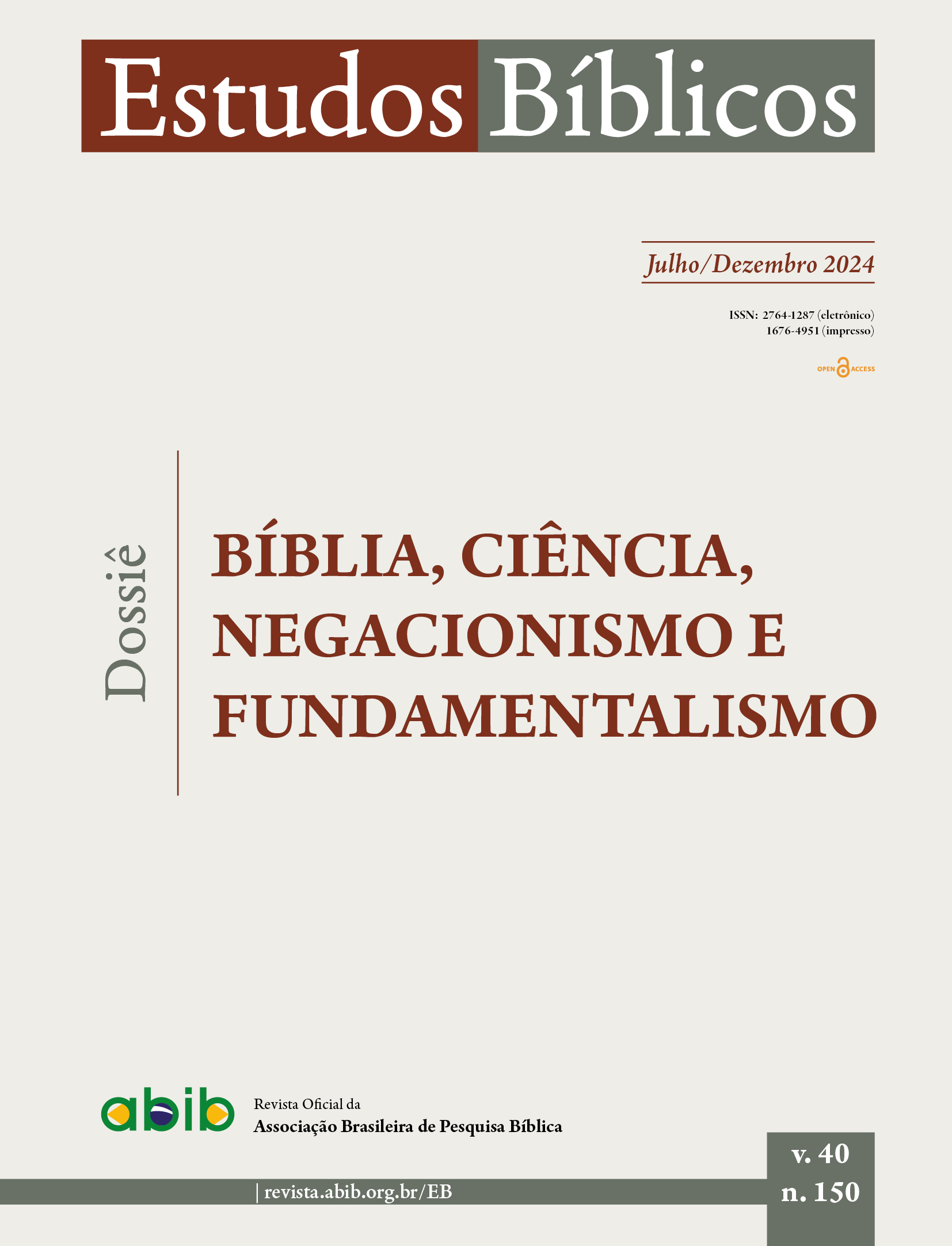The fundamentalist reading of Ps 91:11-12 in Mt 4:6 and Lk 4:10-11: an exegetical study on the mundane instrumentalization of the word of God
DOI:
https://doi.org/10.54260/eb.v40i150.1015Keywords:
biblical fundamentalism, Psalms, Luke, temptation of Jesus, DevilAbstract
In the Gospel texts of Mt 4,6 and Lk 4,10-11, there is a diabolical character, the tempter, quoting Ps 91,11-12, with the purpose of making Christ choose a path of idolatry and corruption, the easiest way to dominate everything and everyone, overcoming any hostile power that wants to prevent this. To support this idea, the devil uses religion and even a distorted reading of the Word of God as an inspired biblical text. It is certainly a misleading theodicy that can be summed up as a representation of vain and/or ideological desires. The diabolical character behaves astutely, supposedly like various leaders representing worldly politics, capable of adulterating the deep meaning of the Holy Scriptures in order to propagate their deadly ideologies. Faced with the complexity of the question of fundamentalism, this study refrains from an exhaustive investigation of this problematic issue, which is so relevant today, focusing its interest on an exegetical, theological and pastoral reading of the pericope of Lk 4,1-14a, without forgetting to emphasize the Matthean account of the temptations. However, the Lukean text offers a chiastic structure capable of highlighting in greater depth the theme of biblical fundamentalism and its causes. In any case, both evangelists present the figure of the devil as an antagonistic being who distorts the meaning of Ps 91,11-12 in order to tempt Jesus of Nazareth, the true Son of God who becomes enigmatic to anyone who decides to read the Word of God dishonestly.
References
ALETTI, Jean-Noël. L’arte di Raccontare Gesù Cristo: la scrittura narrativa del vangelo di Luca. Brescia: Queriniana, 1991.
DANKER, Frederick W. (ed.). A Greek-English lexicon of the New Testament and other early Christian literature. Chicago: University of Chicago Press, 2000.
BRUEGGEMANN, Walter. Teología del Antiguo Testamento: un juicio del Yahvéh. Salamanca: Sígueme, 2007.
CARRIÈRE, Jean-Marie. O livro do Deuteronômio: escolher a vida. São Paulo: Loyola, 2005.
FARRAR, Frederic William. The Gospel According to St Luke. Cambridge: Cambridge University Press, 1893.
GILLINGHAM, Susan E. O Messias nos Salmos: uma questão de história da recepção e o Saltério. In: DAY, John (org.). Rei e Messias em Israel e no Antigo Oriente Próximo. São Paulo: Paulinas, 2005.
GOLD, Michael; HABERMAN, Maggie. Trump’s Newest Venture? A $60 Bible. The New York Times, New York, 26 mar. 2024. Disponível em: https://www.nytimes.com/2024/03/26/us/politics/trump-bible.html. Acesso em: 16/05/2024 18:10 hrs.
GREEN, Joel B. The Gospel of Luke. Grand Rapids: William B. Eerdmans Publishing Company, 1997.
HAHN, Ferdinand. υἱόϛ, oũ, ὁ huios hijo*. In: BALZ, Horst; SCHNEIDER, Gerhard. Dicionário Exegético del Nuevo Testamento: vol. II (λ – ω). Salamanca: Sígueme, 1998. p. 1824-1856
JASPARD, Jean-Marie. Signification psycologique d’une lecture “fondamentaliste” de la Biblie. Revue Théologique de Louvain, Louvain, v. 37, 2006, p. 200-216. DOI: https://doi.org/10.2143/RTL.37.2.2017295
KISTEMAKER, Simon J. The structure of Luke's Gospel. Journal of the Evangelical Theological Society, v. 25, n. 1, p. 33-39, mar. 1982.
KSELMAN, John; BARRÉ, Michael. Salmos. In: BROWN, Raymond E.; FITZMYER, Joseph A.; MURPHY, Roland (org.). Novo Comentário Bíblico São Jerônimo: Antigo Testamento. São Paulo: Academia Cristã; Paulus, 2015. p. 1029-1086.
LEANDRO, Carlos André da Cruz. A persistente leitura fundamentalista da Bíblia. ReBiblica, Rio de Janeiro, v. 4, n. 8, p. 325-338, 2023. DOI: https://doi.org/10.46859/PUCRio.Acad.ReBiblica.2596-2922.2023v4n8p529
LIMA, Narcélio Ferreira; SILVA, Valmor da. Fundamentalismo bíblico. In: BOMBASSARO, Luiz Carlos; NODARI, Paulo César (org). Humanidade: Futuro em comum. Fundação Fênix: Porto Alegre, 2023. p. 165-178. DOI: https://doi.org/10.36592/9786554600941-09
LOUDEN, Caleb T. The Chiastic Arrangement of the Lukan Temptation. The Journal of Inductive Biblical Studies, Wilmore, v. 4, n. 2, p. 129-154, 2017.
MCKENZIE, John L. Dicionário Bíblico. São Paulo: Paulus, 1983.
MORAIS, Pedro da Silva. Diálogo e Cultura do Encontro: um itinerário cristão em tempos de fundamentalismo. Revista Eletrônica Espaço Teológico, São Paulo, v. 10, n. 17, p. 277-286, jan./jun, 2016.
NESTLE, Eberhard; NESTLE, Erwin; ALAND, Barbara; ALAND, Kurt; KARAVIDOPOULOS, Johannes; MARTINI, Carlo M.; METZGER, Bruce M. (ed.). Novum Testamentum Graece. 28. ed. Stuttgart: Deutsche Bibelgeselschaft, 2012.
PONTIFÍCIA COMISSÃO BÍBLICA. A interpretação da Bíblia na Igreja: discurso de Sua Santidade o Papa João Paulo II e documento da Pontifícia Comissão Bíblica. 2. ed. São Paulo: Paulinas, 1994.
ROSSÉ, Gérard. Il Vangelo di Luca: commento esegetico e teologico. Roma: Città Nuova, 2001.
SAINT AUGUSTINE. Expositions of the Psalms 73-98. New York: The New City Press, 2002.
SCHÜRMANN, Heinz. Il Vangelo di Luca: parte prima. Commento ai capp. I,I-9,50. Brescia: Paideia, 1983.
SILVA, Cássio Murilo Dias da. Metodologia de exegese bíblica. São Paulo: Paulinas, 2014.
SMITH, Charles A. Criteria for Identifying Chiasm of Design in New Testament Literature: Objective means of distinguishing chiasm of design from accidental and false chiasm. 2009. Dissertação (Doutorado de Filosofia em Artes) – Universidade de Bristol, 2009.
Downloads
Published
How to Cite
Issue
Section
License
Copyright (c) 2025 Pedro da Silva Morais, Renato Gonçalves da Silva

This work is licensed under a Creative Commons Attribution 4.0 International License.






































